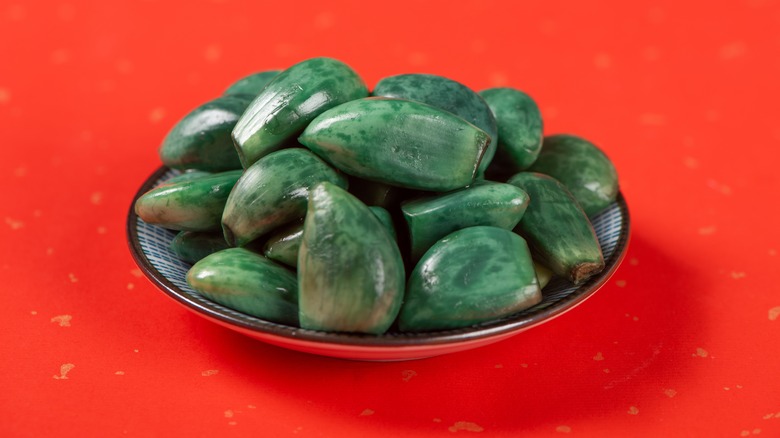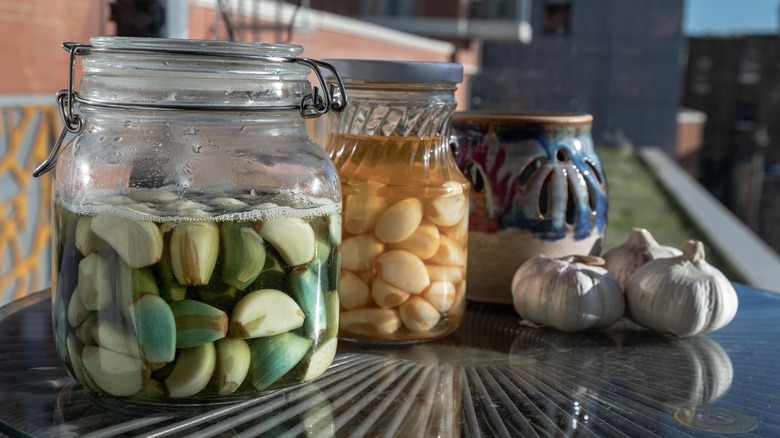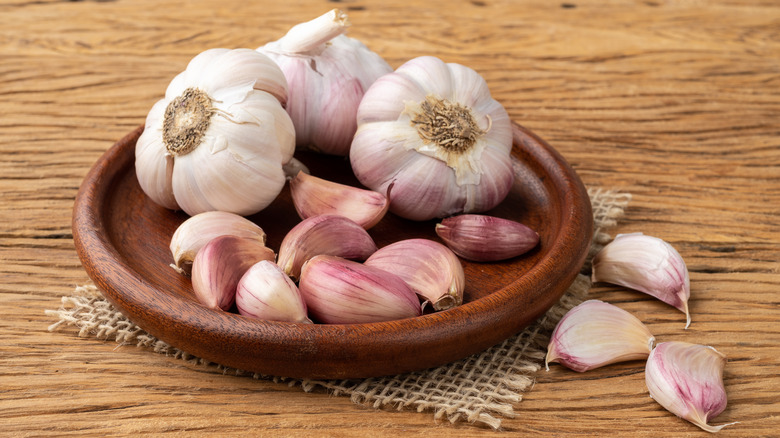2 Common Reasons Your Garlic Turned Blue
When you're cooking with an ingredient as common as garlic, you don't expect surprises. No matter what your level of culinary experience, you've probably dealt with this allium more than a few times, and you know what it looks like. So when you toss chopped garlic into a pan and see it spontaneously turn blue, you must be imagining things... right?
In actuality, garlic turning green or blue is a very real phenomenon. It's easily one of the most alarming experiences one can have in the kitchen, yet it's a fairly common occurrence. You can find dozens of Reddit posts and other queries on social media from bewildered home cooks, wondering why their dinner came out looking like Chef Smurf made it.
You might assume that such a change in color is an indicator of garlic gone bad, but just like the many other myths about garlic, that's not really the case. The color has no effect on its safety or flavor. Unlike the strange taste of sprouted garlic, which raises many diners' eyebrows, blue garlic tastes just as you'd expect. The color change can be chalked up to a simple chemical reaction, mainly triggered by two factors: temperature and acidity.
Changes in temperature and pH affect the enzymes in garlic
There hasn't been much research regarding why some garlic turns blue when cooked, but all signs point to a particular enzyme called alliinase. Garlic contains a sulfuric compound called alliin, and when you crush or chop garlic, alliin mixes with alliinase to form the compound allicin, which is responsible for garlic's sharp aroma, flavor, and health benefits (it was once called "Russian penicillin," after all).
When you mix garlic with an acid, such as lemon juice or vinegar, a unique pH reaction occurs between allicin and various amino acids in the allium. In an interview with Bon Appétit, flavor scientist Arielle Johnson explains that "Alliinase can react with sulfur-containing molecules [like] free amino acids, which create vivid blue and green pigments." Sulfuric molecules plus alliinase form pyrroles, rings of carbon and nitrogen that can cluster together and form these colors.
So, if you see your garlic turn blue, it's probably because you used an acidic ingredient in your dish. However, temperature also seems to play a role. Johnson notes that garlic stored in a cold environment, such as a refrigerator, is more likely to turn blue. The longer garlic is stored like this, the more likely it is to change color, as older cloves appear to be more vulnerable to the reaction.
How to prevent garlic from turning blue
Beyond aesthetics, there's no real reason to be scared of blue garlic. In fact, some cultures embrace it. Laba garlic, a Chinese condiment made of garlic cloves pickled in rice vinegar, is prized for its blue-green hue. The combination of garlic with vinegar and sugar creates a flavor profile that is sour, sweet, and spicy. It's often enjoyed alongside dumplings, and has historically been used as an offering to ancestors and deities.
If you (or your family members) just can't get around the blue hue, there are ways to avoid it. Unfortunately, keeping strongly acidic ingredients away from garlic is the most effective move, so a garlicky vinaigrette or lemon-garlic pasta might be off the table. A more flexible tip is to store your garlic at room temperature and use it within a couple of months.
It's important to note that garlic should only turn blue when it's cooked with an acid. If you peel a raw clove and find that it has turned blue or green, what you're really looking at is mold. You can tell mold apart from other discoloration because it typically appears in small patches, whereas the alliinase reaction turns the whole clove blue. Moldy garlic will also have a rough texture. You should toss out moldy cloves, but if they turn blue mid-cooking? It's better to not waste them and just embrace the hue.


